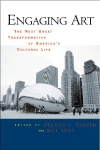« So many changes, so many questions... | Main | What If Video Saved the Radio Star? »
June 13, 2007
So you think you can dance?
by Alan S. BrownHi all. First of all, this is a great book with some really fine essays that are relevant to both artists and administrators. I had the opportunity to participate as a reviewer earlier in the book's development process, and there's a lot of good stuff here. I especially recommend the pieces by Lynne Conner and Barry Schwartz.
While the various authors look at many aspects of the changing landscape of cultural participation, I would like to focus initially on the unifying construct of engagement. What does "engage" mean to you? That word seems to be on the tip of a lot of tongues lately, though I'm not really sure that we have any sort of shared understanding of what it means. Engage has many different meanings. To have an engaging conversation means that you were meaningfully involved and found it especially interesting or spirited. Getting engaged is a pre-nuptial tradition, which, at its core, is about expectation and mutual commitment. The word also has a business sense (to be engaged to perform), and also a mechanical sense (the gears engaged). Looking across all the senses of the word, I find several core elements of meaning:
• mutuality of intent; common cause
• unusually high level of interest, involvement or participation
• collaboration and partnership
• both parties accepting risk for an uncertain outcome
• to become interlocked or intertwined
Do you accept that these are the new precepts of cultural participation? If so, how will that affect how you make programming decisions? Do you see your audience as a beneficiary of your curatorial prowess, or as a partner and co-creator of meaning? When did education get separated from core programming? How does the job description of the artist change? How does the structure and governance model change? How can you be relevant to consumers in the settings where they create meaning? Developing answers to these questions is proving to be profoundly challenging for all types of cultural organizations.
Witness the rise of the citizen artist, whose home is a museum, whose automobile is a concert hall, and whose bedroom is a cinema. It's an amazing revolution. That artistic expression has entered back into common practice and achieved a new relevance in society is truly heartening. It makes me wanna dance. So why has this phenomenon largely bypassed our nonprofit delivery system? Whose job is it to nurture and engage the citizen artist?
Posted by abrown at June 13, 2007 10:46 PM
COMMENTS
Whose job - I have been thinking alot about this in the last few years, as I moved to Europe and Britain and then back again. It seems clearer and clearer to me that it is not any one person or entity whose 'job' art is. Its a cultural (as in societal) business.
Given time, space, some money, artists think differently. Not necessarily 'better' but, differently. If art and the production/presentation of art is a business and not a charity, programmers have a different career path, and a different mind set.
If the discussion can center around ideas about making, presenting, and access, rather than crisis funding, it is a different discussion.
And - people will ALWAYS be citizen artists. Again, given any opportunity to be proactive, and an ability to feel effective in the world, things get made, get arranged, get framed, are valued for their beauty, for the joy they provide the maker and the caretaker, for the statement they allow the creator to present to the world.
Posted by: Lbrenner at June 14, 2007 7:28 AM
Post a comment
Tell A Friend
Resources
Engaging Art: The Next Great Transformation of America's Cultural Life Chapter downloads MP3s Vanessa Bertozzi on audiences and participation Vanessa Bertozzi on involving artists in work Steven Tepper argues the historical context of arts in America
Abstracts
Chapter 4
In & Out of the Dark - (a theory about audience behavior from Sophocles to spoken word)
Chapter 7
Artistic Expression in the age of Participatory Culture (How and Why Young People Create)
Chapter 8
Music, Mavens & Technology
(all chapters in pdf form)
Steven Tepper talks about technology and the future of cultural choice
Lynne Conner on the historical relationship between artist and audience
Lynne Conner on event and meaning and sports
AJ Blogs
AJBlogCentral | rss
culture
Terry Teachout on the arts in New York City
Andrew Taylor on the business of arts & culture
rock culture approximately
Rebuilding Gulf Culture after Katrina
Douglas McLennan's blog
Art from the American Outback
Scott McLemee on books, ideas & trash-culture ephemera
Jan Herman - arts, media & culture with 'tude
dance
Apollinaire Scherr talks about dance
Tobi Tobias on dance et al...
media
Jeff Weinstein's Cultural Mixology
Martha Bayles on Film...
music
Greg Sandow performs a book-in-progress
Howard Mandel's freelance Urban Improvisation
Focus on New Orleans. Jazz and Other Sounds
Exploring Orchestras w/ Henry Fogel
Kyle Gann on music after the fact
Doug Ramsey on Jazz and other matters...
Greg Sandow on the future of Classical Music
Norman Lebrecht on Shifting Sound Worlds
publishing
Jerome Weeks on Books
visual
Public Art, Public Space
John Perreault's art diary
Lee Rosenbaum's Cultural Commentary
Tyler Green's modern & contemporary art blog
Special AJ Blogs
June 14-20, 2007



